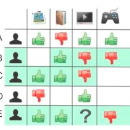Understanding why specific items are recommended to users can significantly increase their trust and satisfaction in the system. While neural recommenders have become the state-of-the-art in recent years, the complexity of deep models still makes the generation of tangible explanations for end users a challenging problem. Existing methods are usually based on attention distributions over a variety of features, which are still questionable regarding their suitability as explanations, and rather unwieldy to grasp for an end user. Counterfactual explanations based on a small set of the user's own actions have been shown to be an acceptable solution to the tangibility problem. However, current work on such counterfactuals cannot be readily applied to neural models. In this work, we propose ACCENT, the first general framework for finding counterfactual explanations for neural recommenders. It extends recently-proposed influence functions for identifying training points most relevant to a recommendation, from a single to a pair of items, while deducing a counterfactual set in an iterative process. We use ACCENT to generate counterfactual explanations for two popular neural models, Neural Collaborative Filtering (NCF) and Relational Collaborative Filtering (RCF), and demonstrate its feasibility on a sample of the popular MovieLens 100K dataset.
翻译:了解向用户推荐特定项目的原因,可以大大提高用户对系统的信任和满意度。虽然神经建议者近年来已成为最先进的系统,但深层模型的复杂性仍然使得为终端用户提供实际解释成为具有挑战性的问题。现有方法通常基于对各种特征的注意力分布,这些特征对于是否适合作为解释仍然有疑问,而且对于最终用户来说难以掌握。基于用户自身行动一小部分的反事实解释被证明是对相容问题的可接受的解决办法。然而,目前关于这些反事实的工作不能轻易适用于神经模型。我们在此工作中提议ACCENT,这是为神经建议者寻找反事实解释的第一个总体框架。它最近提出的确定与建议最相关的培训点的影响力功能,从单项到一对一对项目,同时在迭接过程中淡化一个反事实设置。我们利用ACENT为两种流行的神经神经网络模型,即神经协作过滤(NCFF)和Relational Cooperation Clastical 数据(RCF)制作反事实解释。



